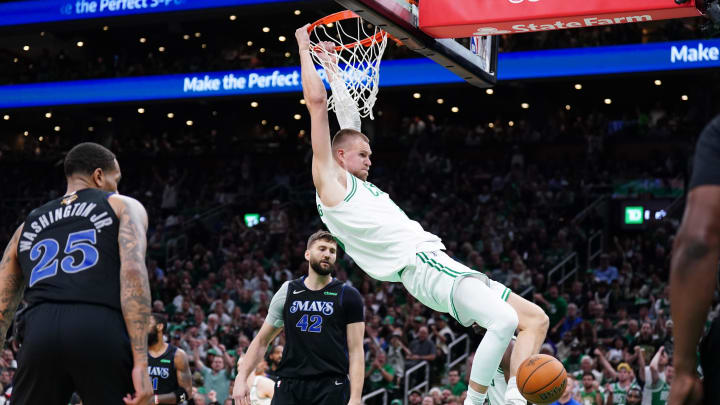Former Buccaneers Physician Details Kristaps Porzingis' Injury, Challenges, and if He'll Need Offseason Surgery

Right before the Celtics started their availability during media day at the American Airlines Center on Tuesday, the team released a concerning update on Kristaps Porzingis.
Per the team, the seven-foot-three center suffered a torn medial retinaculum, allowing dislocation of the posterior tibialis tendon in his left leg.
The injury occurred late in the third quarter of Boston's 105-98 Game 2 victory.
The Celtics list the Latvian native as questionable due to a left posterior tibialis dislocation on their initial injury report for Wednesday's matchup in Dallas.
Per the National Library of Medicine, according to a 2006 study, there were only 32 documented cases of a dislocated posterior tibial tendon in all of English literature.
As Porzingis fights to remain in the lineup, Inside The Celtics spoke with orthopedic surgeon Dr. Robert Volk, who previously served as a team physician for the Florida Panthers and Tampa Bay Buccaneers, to understand the likelihood of him continuing to suit up, how it might impact his performance, the risk of further injury, and whether he'll require offseason surgery, among other topics related to his left posterior tibialis dislocation.
Bobby Krivitsky: The Celtics say Porzingis suffered a torn medial retinaculum, allowing dislocation of the posterior tibialis tendon, and list him as questionable due to a left posterior tibialis dislocation. Could you please explain this injury in lamens terms?
Dr. Volk: Now, the medial retinaculum, that is a fibrous band of tissue that acts as a roof, if you will, for something called the tarsal tunnel, and if there is an injury to that retinaculum or a stretching or something like that, the tendon can, doesn't always, but can slide out of its position and pop over that bone that you feel on the inner part of your ankle and rest out of position.
We call that a dislocation most of the time by putting the ankle down or plantar flexion. Sometimes, it requires a little gentle push, but that tendon usually goes back to its normal home. But once that retinaculum has been disrupted, (then) a lot of times, it doesn't return to its pre-stretched out position. And so, it's the athlete is then prone to resubluxation of that tendon and reinjury to that tendon.
Bobby Krivitsky: Perhaps you heard that he said about the injuries he's battling through, "I'll die out there," and he's fighting and doing everything he can to be able to play in Game 3 and the rest of the Finals.
We saw him walking around without a limp, although he did have a sleeve on his left ankle. How do you think this would impact what he's able to do on the court physically if he plays?
Dr. Volk: Well, assuming that the trainers and the doctors have been able to get the inflammation under control, as you can imagine, when a tendon slips out of place, there's a lot of inflammation and pain that goes with that. So, assuming that they've been able to get that under control and his pain is reasonable -- his tendon, as long as it stays home, he should be able to do just about anything he needs and wants to do.
The concern would be if he were to land awkwardly from a jump onto another player's foot or something like that, (which) often happens in basketball. He could sustain a reinjury. So, I imagine the trainers and then the medical team are working very hard to make sure that they tape his ankle and provide as much stabilizing support to that ankle as they can.
So, a high-level athlete like him, you would fully expect him to have that attitude of, 'This is the finals; I'm gonna do whatever I can to be part of it.' And that's what you want out of your athlete. But if they can't get the inflammation under control, if his pain is such that he can't do any lateral shifting or dynamic movement with his ankle, this is one of the stabilizers of the foot and the arch and the ankle. So, he may not be able to go if they can't control those things.
Bobby Krivitsky: Porzingis recently returned from a soleus strain in his right calf that cost him 38 days and 10 games. While the Celtics' press release said these two injuries are unrelated, what is your opinion on the matter? Do you think this was connected in the sense trying to compensate for that injury led to this one?
Dr. Volk: That's hard to opine upon because we're talking about different muscle groups and different functions in the leg. The soleus is one of the calf muscles in the back of the leg that attaches to the Achilles tendon and provides dynamic force across the heel bone, which allows a player to run, sprint, (and) that sort of thing.
This is more of a stabilizing tendon. So, I think they're actually isolated injuries. Although, it's hard to say. I don't know what the MRI or what any of those other studies look like for his soleus injury. Sometimes, the soleus and the posterior tibialis muscle are actually in very close proximity in the leg. So, it's possible.
Unless the MRI confirmed that was indeed the soleus, it could have been an injury to this, but that being said, the location of the soleus strain is gonna be more in the mid-calf, whereas this injury is at the ankle. So, they're in different geometric positions and (in) different muscle groups with different functions. So, I don't think they're directly related.
Bobby Krivitsky: Is this more a matter of pain tolerance compared to the risk of further injury?
Dr. Volk: Well, I mean, that would be probably the decision that the medical team would make about whether or not he could try to play is based on his pain level, and then they'll have him test during warm-ups. If he suits up tonight, see how he moves around the court.
If he's making quick, dynamic movements with his ankle and doesn't seem to be wincing, then that's a good indicator, in terms of prevention of re-injury. If he were to have another dislocation event of that tendon, who knows what could happen?
If his pain causes him to -- his knee to buckle and fall, and then he injures his knee or something worse, right? So, yes, you want to prevent the athlete from hurting themselves, but I would say that this one, if he feels up for going and he passes the functional tests that the trainers and coaches give him, then he should be able to play.
Bobby Krivitsky: And would holding him out until Game 4 carry enough benefits to make that a worthwhile move?
Dr. Volk: It depends on the inflammation. He's had some rest since Game 2. So, he's had some rest, a couple of days of rest, and an athlete like this with the sort of medical facilities and training staff and physical therapy staff that they have, if they've got that inflammation and pain under control, there's no reason he couldn't go tonight.
Now, if the opposite is true, (if) he's not there yet. (If) his inflammation is not under control and he can't do any of those dynamic moves that we mentioned, then yeah, giving him more rest makes sense.
Bobby Krivitsky: If he does play, will they have to keep his shifts short?
Dr. Volk: A lot of that is going to be predicated on his pain level and his inflammation and his ability (and) to the trainer's ability to keep that tendon in the location it's supposed to be in.
You would think that if the tendon stays home, so to speak, and his inflammation and pain are under control, he could probably play a full game. Now, if he sustains a reinjury or tweaks it during warm-ups or something like that, then all bets are off.
Bobby Krivitsky: Is this an injury you anticipate requiring off-season surgery?
Dr. Volk: Almost certainly. Almost every case report that I'm aware of. First of all, it's a very rare injury, but it is reported in the literature. But every case report that I've read -- conservative treatment tends to not be very successful.
So, especially in a high-level athlete, you usually are gonna undergo surgery to either tighten or recreate that retinaculum. And in some cases, the surgeon would do a deepening surgery where they recreate a little bit more of a deeper tunnel in the bone behind the inner ankle to make sure that tendon doesn't slide out anymore.
Bobby Krivitsky: And once he has surgery, is there still an increased risk of reinjuring this, or he should be ok moving forward?
Dr. Volk: Yeah, after successful surgery and a recovery course, there's (a) very low risk of re-injury. We never say never, but it's highly unlikely that he'll sustain this type of injury a subsequent time. So, usually, the surgery is very successful.
Bobby Krivitsky: Lastly -- and you don't have to answer this if you don't want to -- do you have a series prediction for the NBA Finals?
Dr. Volk: It's funny, my son told me that he thought Dallas was going to win in six, and he actually thought Boston would go down three games straight, and he couldn't be more wrong.
My extended family is all Boston fans. So, I'm sort of pulling for Boston. But it's the Finals, and anything can happen.
Bobby Krivitsky: I'm sure they'd love to see you at the parade.
Dr. Volk: Yeah, that sounds good!
Further Reading
What to Know About Injury Threatening Kristaps Porzingis' NBA Finals Availability
Celtics React to Injury That May Sideline Kristaps Porzingis for NBA Finals
Jrue Holiday's 'Championship DNA' Rubbing Off on Celtics
Stifling Defense Moves Celtics Halfway to Banner 18
Jayson Tatum's Joy Outweighing Pressure of NBA Finals Return
Inside the Moment that Propelled Celtics to NBA Finals Game 1 Win
Celtics Set the Tone for the NBA Finals with Game 1 Haymaker
Kyrie Irving Shares Regret and What He Takes from Playing in Boston
Joe Mazzulla Eviscerates Contrived Narrative about Jayson Tatum and Jaylen Brown
Al Horford Returns to NBA Finals Aiming to Add to a Legacy Already Cemented
